Your Complete Guide to Home Siding
Your home’s siding not only keeps your house looking great, but also creates a barrier that protects against damage from rain, wind and sun. The weather in Central Ohio can be especially harsh and truly put your siding to the test. As a result, your siding will naturally experience wear and tear and need to be replaced. Home Inspections LLC has put together a complete guide to home siding that will help you inspect your home, determine whether you are due for a replacement and much more.
Wood Siding
Wood siding is a beautiful addition to any home, but it does require a certain amount of upkeep and will need to be replaced over time. Here are some tips to help you determine whether your wood siding is due for an upgrade:
Start with a simple visual inspection. If the wood is rotting or warping, this should be easily visible and a good sign that it is time to replace the siding. Be sure to inspect the entire siding from the ground up to the roof line. Next, take a screw driver and do a poke test. Rotten siding will be soft and give way. Is the paint on your siding chipping or fading? While wood siding will need to be repainted every 3-5 years, it should hold paint and look good for a few years at a time. If you notice that the color and shape of the wood is changing, there may be an underlying problem.
Fading paint can also make your home look old and worn. Replacing the wood siding and adding a new coat of paint can add more life and vibrancy in increase curb appeal.
A visual inspection will also reveal any cracked or loose boards. A few pieces of wood siding can be repaired and secured back in place, but if there are large areas that need to be fixed, it may be time for a complete replacement.
Look for signs of mold and mildew. Moisture is the biggest enemy of wood siding. Mold and mildew can collect, especially along the seams between boards and excessive moisture can lead to bigger problems. If moisture has already caused damage to your wood siding, you will want to invest in a replacement project before water is able to get to the structural components of your home.
Stucco Siding
While stucco is a beautiful siding option that offers a unique decorative exterior, most stucco installation projects are not done correctly. In fact, approximately 90% of all stucco homes built within in the past 15-25 years were improperly executed. That means that these homes are vulnerable to leaks, mold and structural damage caused by excessive moisture. Unfortunately, most homeowners in Central Ohio and beyond aren’t aware that their home is experiencing problems until it is too late.
Problems with stucco are especially difficult because the damage can occur within the wall and well out of sight. A professional stucco inspection is the only way to accurately detect problems. If issues are caught in time, they can be addressed with simple repairs and resurfacing.
Home Inspections LLC offers both Level 1 and Level 2 stucco inspections that will help you identify any problems and provide you with a detailed look at the state of your stucco. Using our expertise and the latest technology, we can gain a better understanding of your home and make recommendations for repairs.
Level 1 Stucco Inspection
The Level 1 stucco inspection consists of a thorough visual observations. During this process, your inspector will look for:
- Signs of mold, mildew, efflorescence and staining on the surface
- Any physical damage including cracking
- Proper installation according to industry standards and manufacturers specifications
- Presence of kickout, door and window flashing
- Vents with proper flashing
- Backer rod and sealant installation where necessary
- Proper expansion and control joints
- Presence of functional weep screed and weep ropes
Level 2 Stucco Inspection
Once the inspector has completed a visual inspection and recorded detailed notes, they will move on to the second stage of the process. This involves using tools to actually penetrate the wall, take core samples and measure the moisture levels within the stucco. High moisture readings could mean that both the stucco and the substrate have been damaged. The inspector will use the level 2 results to determine the extent of damage and make recommendations for repairs.
What are the signs that water is building up in my stucco walls?
While a visual inspection is helpful, the only way to know for sure whether water has been building up in your stucco walls is to undergo a level 2 inspection. There is no surefire way to know exactly how much moisture is in the walls without taking a core sample using a probe. If your Central Ohio home has never undergone a stucco inspection, it is time to call Home Inspections LLC and schedule an appointment. The sooner you are able to catch moisture problems, the less costly the repairs will be.
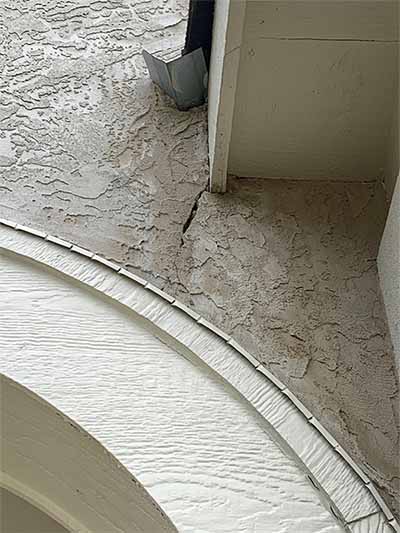
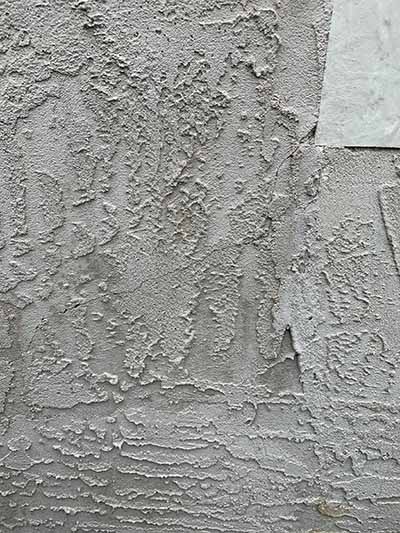
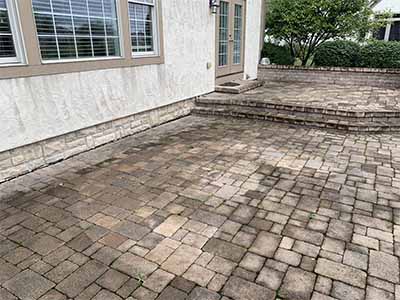
Fiber Cement Siding
Fiber cement siding is a relatively new product that is becoming increasingly popular with homeowners. It offers a strong structural integrity, which provides an added level of protection from the elements. While fiber cement is a solid material, it is still susceptible to problems, most of which occur when is has been improperly installed. To avoid problems, including rotting siding, be sure to do your research and work with an experienced contractor who is familiar with fiber cement siding and only uses the highest quality products.
Common Problems with Fiber Cement Siding
Fiber cement siding has a reputation for being difficult to install. This can lead to more problems for homeowners since manufacturers’ warranties are only valid if the product has been properly installed. An inexperienced contractor can leave you with bad siding, a voided warranty and the cost of repairs.
The most common problem that occurs with fiber cement siding is moisture seeping into the siding through the seams. Since the siding consists of wood particles and cement, it readily absorbs excess moisture, which can easily cause major damage. If a water barrier has not been installed, this moisture can work its way to the home’s plywood and lead to even more rot. While fiber cement siding offers certain advantages, it must be properly installed in order to provide maximum protection.
Masonry Inspection
Masonry is also commonly used in home exteriors and also needs to be regularly inspected. Common problems with masonry include:
- Cracking
- Leaning
- Spalling
- Bowing or vertical bulges
- Sweeping or horizontal bulges
- Crumbling mortar
A masonry inspection will begin by determining which walls are load bearing. An inspector will usually enter the crawlspace or attic to look at the beams and joists in order to identify load bearing walls and other non-structural masonry walls.
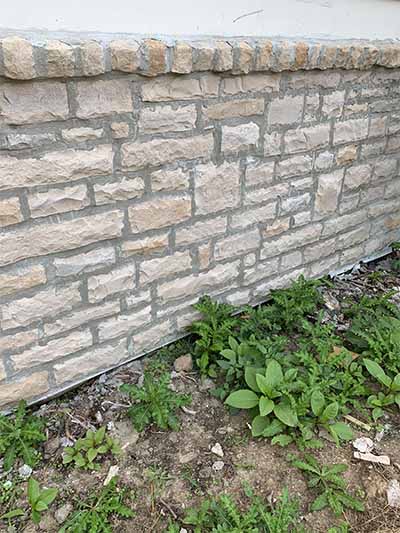
Thermal Cracking in Masonry Walls
Masonry walls are designed to be somewhat elastic so that they can safely move over time. Smaller movements will cause small cracks that are safe and won’t affect your home. Brick walls will naturally expand and contract according to weather conditions and this can also cause cracking, especially near doors and windows and under roof eaves. While these cracks should be monitored, they are normal and cyclical. A flexible sealant can be used to help close up active cracks while still allowing for movement.
However, larger movement and other conditions can cause more sizable cracks that will need to be addressed. Common causes of cracks include:
- Foundation settling
- Expansion and contraction caused by weather and moisture
- Poor support
- Regular freeze and thaw cycles
- Movement among building materials
- Corrosion of metal wall reinforcement materials
There are other structural stressors that can cause masonry to bulge, lean and buckle. Masonry walls will often become displaced where arches occur or around wood lintels that cover doors and windows. As wood decays and metal rusts and corrodes, additional stress is put on the walls, which can cause displacement. These problem areas can be fixed by adding reinforcement.
Pitched roofs with failing horizontal roof ties can also begin to spread outward and put excessive lateral pressure on masonry walls. This can push the walls out from the roof and eaves, causing further structural problems. Weak and leaky roofs can also end up transferring too much load onto the walls. An inspector will need to examine the attic and the roof in order to determine the root of the problem. Once the roof has been repaired, the damaged masonry can be addressed.
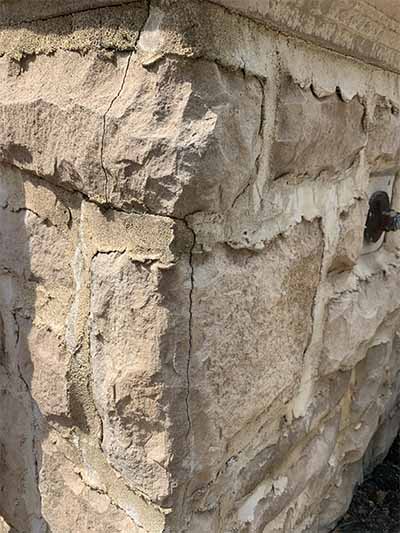
Repairing Damaged Masonry Walls
Repairing masonry walls will often require a process known as pointing, which involves replacing the external section of mortar joints. While pointing is a common repair, it does require a certain amount of expertise. If pointing is done incorrectly, it can actually cause more damage to the home.
An experienced mason will make sure that new mortar has the same color, permeability and hardness as existing mortar. If the mortars are not properly matched, the surrounding masonry will deteriorate at an accelerated rate. When applying the pointing, the mortar must be carefully controlled so that all of the joints are the same width and no excess mortar is left on the brick. This technique requires skill and experience.
Homeowners who are unhappy with the appearance of their brick or want to slow deterioration will often paint the brick or cover it in a waterproofing product. In many cases, the brick has become unsightly after receiving an abrasive treatment, such as sandblasting, that removes the outer surface of the brick and exposes the soft core. These types of treatment actually make the brick more susceptible to moisture and the problem is only made worse by adding a coating that traps moisture in the brick.
If any type of coating is applied to brick, it must be a water-permeable product in order to prevent causing further damage. It is also important to remember that deteriorating bricks could be a part of a larger problem and shouldn’t simply be covered up.
Schedule Your Inspection
Whether you have wood, stucco, cement fiber or masonry siding protecting the exterior of your Central Ohio home, it is important to make sure your siding is in the proper condition. Once your siding is damaged, the rest of your home is at higher risk of damage. Call Home Inspections LLC today to make sure your siding is functioning properly and make any necessary repairs before small issues turn into major problems.
Have Questions About a complete Home Inspection in Columbus Ohio?
Request a Home inspection in Columbus OH. Fill out the form below and we will give you a prompt reply.
"*" indicates required fields
